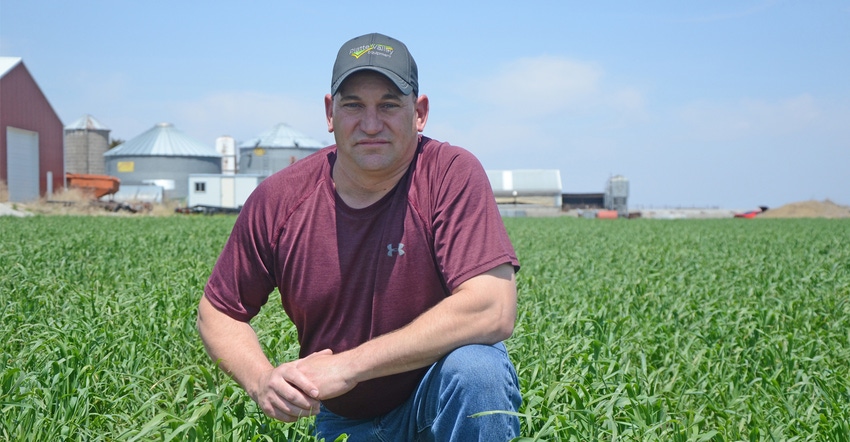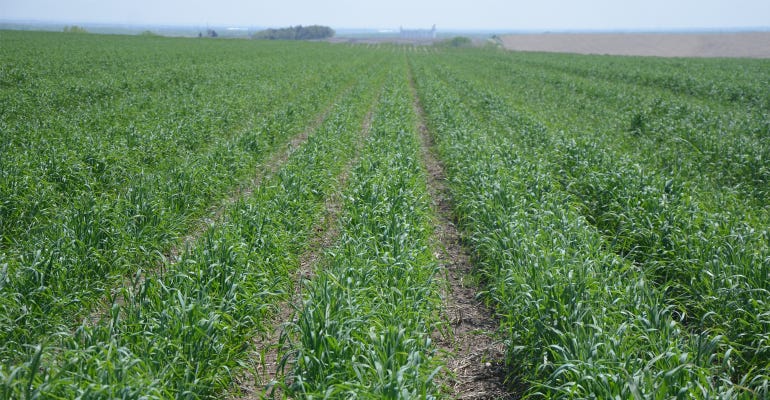
You've heard of twin-row corn, but twin-row cover crops? It's something that Greg Keller has been practicing on his farm near Monroe, Neb., for the past five years.
Cover crops have been a good fit for Keller, who's made it his goal to reduce erosion and runoff and has practiced no-till for 19 years. However, he ran into hurdles after he first tried planting corn directly into solid-seed rye six years ago. After a wet spring, it had reached more than 24 inches in height.
"The corn struggled to come through it. It took an extra week or week and a half," Keller says. "The corn finally rooted out, and it took a long time to push through the rye. The corn plants we thought stretched a little too much. There were a couple of rows where the corn grew better where there was no competition from the rye. I watched it throughout the entire growing season, and that's when I decided to do twin-row rye, and leaving two rows open."
"With twin-row rye, there's no competition to slow the corn down now when it comes up," he adds. "Now it comes right up through the bean stubble and takes off."
Keller plants cereal rye on twin rows using a 30-foot Great Plains drill with 7.5-inch spacing, shutting two rows off, leaving two rows on and so on.
"We plug two rows, and it's got to be measured out so the RTK matches with the old cornstalk butts," he says. "We lined it right up and just took off planting off to the left or right of the old cornstalk butts. I seeded 1 pound of rye to the acre, and they're seeded down 1 inch to 1.5 inches."
This year, he says, he saw his biggest stand yet — more than 24 inches and up to 30 inches in some places.
"Depending on how tall it gets, the rye will go down 3 to 4 feet, the roots will bring nitrogen back to the surface," Keller says. "We're recycling the nitrogen. And we're also finding out it raises our organic matter. It also helps with weed control and erosion. There's no erosion or water coming out of my fields. The nitrogen and the chemicals all stay in the field, and doesn't run down the ditch. The biggest thing we've found is it bumped up our yields."
Keller estimates a yield bump of anywhere from 10 to 25 bushels per acre for his irrigated corn planted after rye, which varies depending on when the rye is terminated.

TWIN-ROW RYE: Keller plants cereal rye on twin rows using a 30-foot Great Plains drill with 7.5-inch spacing, shutting two rows off, leaving two rows on and so on.

Keller typically terminates his rye using a burndown of glyphosate mixed with 120 pounds of 32% UAN solution and a pound of sugar per acre.
"Normally, we spray after planting corn, but every year's different," he says. "The last two or three years here, the rye didn't get very tall, maybe up to 12 inches. We found out after you're done harvesting your cash crop, you need to plant rye as soon as possible. Then in spring, you're going to have to determine when you want to do the burndown."
Keller notes sugar is included in the mix to provide a carbon source to help break down any residue remaining from the previous cash crop.
"Every time we spray, we put a pound of sugar on, and it melts the stalks to nothing," he says. "It even works on the bean stubble. We can go out there in the field when we harvest beans, and you can hardly find any cornstalks leftover — literally nothing left. They just melt to nothing. Out here in my field, a lot of the bean stubble is just about gone. It's all decomposed since I planted. I believe that's also got a lot to do with the 19 years we've been doing no-till."
This spring's weather was ideal for cereal rye — while it started out cool and dry, the wetter weather later on gave a bigger window for growth.
"This year when I planted corn, the rye wasn't really tall. Then we had a few weeks where it just exploded," Keller says. "I had the corn planted and it germinated, but it took longer for the corn to come up. I was probably a week and a half later terminating the rye this year, and it still worked out great. The corn was coming up only three or four days later."
About the Author(s)
You May Also Like






